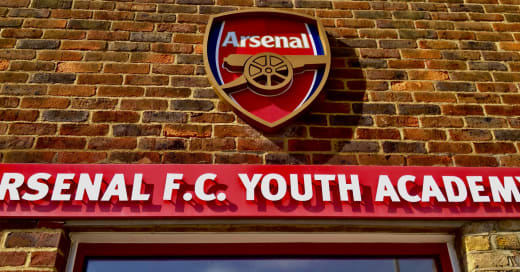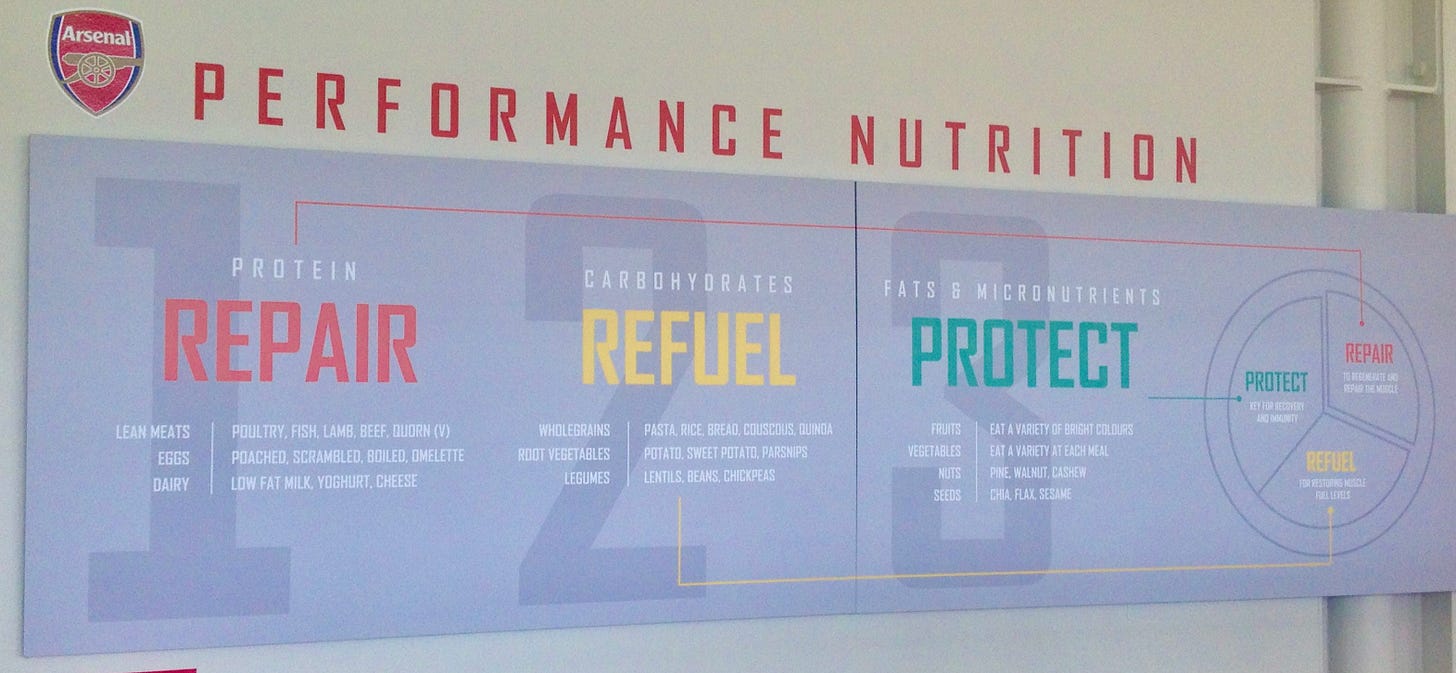Understanding Youth Athlete Development: Contributions from the Premier League Academies
A compilation of research papers
The beautiful game. Association football, or as commonly referred to in North America – soccer. It’s the most popular sport in the world with 3.5 billion fans.
It also provides us with great insights into the science of youth athlete development. In particular, the English Premier League academy system has provided a wealth of research papers on topics ranging from training load to nutrition to speed development to biobanding and more. This is not to dismiss the contributions of other youth soccer academy systems in Germany, Spain, France and the Netherlands, which have also produced some great information and knowledge about youth athlete development. However, I’ll admit that I’m a wee-bit biased given my on-site visits to Hale’s End (Arsenal), Southampton and a few others plus my connection to many of the sports scientists & strength and conditioning coaches across the Premier League academies.
My view and understanding, albeit still as a bit of an outsider, is that the Elite Player Performance Plan (EPPP) of 2012 influenced the increased scholarly activity within the Premier League academies to better understand youth athlete development. Overall, the EPPP was designed to revamp the academy system and develop more and better homegrown players. Part of this resolve was an increase in the number of sports science and sports medicine related positions at the Academy level and a commitment towards improving and standardizing the evaluation and monitoring of player development via the League’s Performance Management Application (PMA) and Injury Surveillance system. These strategies were further supported through educational initiatives and workshops designed to improve knowledge and awareness of player development among sports science and medical practitioners, coaches and scouts. In turn, many of these academy staff have taken advantage of these opportunities, engaging with academic experts and pursuing graduate level degrees, publishing studies from data collected in their very own ‘Living Lab’. Many of the initiatives that the Premier League has championed, such as bio-banding, are a direct result of this work putting practitioners at the forefront of driving innovation and change. Furthermore, clubs have invested in embedded scholar-practitioners with university partners and/or collaborations with university professors.

The widespread acceptance of understanding the importance of (and application of) normal growth and maturation on youth athlete development by this group of scholar-practitioners must be applauded. And I must acknowledge my friend and colleague Dr. Sean Cumming for his efforts in continuing to educate and collaborate and mentor the academy clubs and staff who pursue this work. I’m sure he would also acknowledge the trailblazing efforts of our mentor, Professor Bob Malina, who shared with us his knowledge of the growth and maturation of young athletes and his experiences collaborating with various European soccer academies (list of 56 papers here).
For now, here is a compilation (with links) of publications by topic area from Premier League academy staff. Thank you for your contribution to our understanding of youth athlete development, and to best practices in sport science – “work, finish, publish” (quote from Michael Faraday) - and program evaluation – Plan | Do | Study | Act. In the future, I hope to expand on a few of these topic areas or specific papers. I also hope that other sporting organizations or sport systems can be inspired by the approach taken with many Premier League academies and develop their own ‘Living Labs’.
Structure and Process
A survey of organizational structure and operational practices of elite youth football academies and national federations from around the world: A performance and medical perspective. Front Sports Act Living 2022 Nov 23:4:1031721
A Multidisciplinary Investigation into the Talent Development Processes at an English Football Academy: A Machine Learning Approach. Sports (Basel) 2022 Oct 19;10(10):159
Developing World-Class Soccer Players: An Example of the Academy Physical Development Program From an English Premier League Team. Strength Cond J, 2017
Talent ID/Selection
Maturity-Associated Polygenic Profiles of under 12-16-Compared to under 17-23-Year-Old Male English Academy Football Players. Genes (Basel) 2023 Jul 12;14(7):1431
Observations of Player (de)Selection Within a Professional UK Soccer Academy. J Sci Sport Exerc 2023 Mar 8:1-10
"From everything to nothing in a split second": Elite youth players' experiences of release from professional football academies. Front Sports Act Living 2022 Jul 22:4:941482
Coaches’ Evaluations of Match Performance in Academy Soccer Players in Relation to the Adolescent Growth Spurt. J Sci Sport Exerc August 2020
Relative Age Effect
Hill on a mountaintop: A longitudinal and cross-sectional analysis of the relative age effect in competitive youth football. J Sports Sci 2020 Jun-Jun;38(11-12):1352-1358
Relative age and maturation selection biases in academy football. J Sports Sci 2020 Jun-Jun;38(11-12):1359-1367.
Training Load & Physical Demands
Monitoring Practices of Training Load and Biological Maturity in UK Soccer Academies. Int J Sports Physiol Perform 2021 Mar 1;16(3):395-406
Maturity-associated considerations for training load, injury risk, and physical performance in youth soccer: One size does not fit all. J Sport Health Sci 2021 Jul;10(4):403-412
Match analysis of U9 and U10 english premier league academy soccer players using a global positioning system: relevance for talent identification and development. J Strength Cond Res 2015 Apr;29(4):954-63
Seasonal training and match load and micro-cycle periodization in male Premier League academy soccer players. J Sports Sci 2021 Aug;39(16):1838-1849
Motion analysis of U11 to U16 elite English Premier League Academy players. J Sports Sci 2015;33(12):1248-58
Motion analysis of match-play in elite U12 to U16 age-group soccer players. J Sports Sci 2010 Nov;28(13):1391-7
Effect of Playing Status and Fixture Congestion on Training Load, Mental Fatigue, and Recovery Status in Premier League Academy Goalkeepers. J Strength Cond Res 2023 Feb 1;37(2):375-382
Physical Qualities/Strength & Conditioning
Change of direction frequency off the ball: new perspectives in elite youth soccer. Sci Med Footb 2022 Nov;6(4):473-482
Effect of long-term soccer training on changes in cardiac function during exercise in elite youth soccer players. Scand J Med Sci Sports 2022 May;32(5):892-902
The relationship between eccentric hamstring strength and dynamic stability in elite academy footballers. Sci Med Footb 2021 Feb;5(1):48-54
The Effects of a Soccer-Specific Fitness Test on Eccentric Knee Flexor Strength. J Sport Rehabil 2020 Nov 20;30(4):568-572
Soccer-Specific Reactive Repeated-Sprint Ability in Elite Youth Soccer Players: Maturation Trends and Association With Various Physical Performance Tests. J Strength Cond Res 2020 Dec;34(12):3538-3545
Static stretching does not enhance recovery in elite youth soccer players. BMJ Open Sport Exerc Med 2017 Apr 22;3(1):e000202
Jumping Asymmetries Are Associated With Speed, Change of Direction Speed, and Jump Performance in Elite Academy Soccer Players. J Strength Cond Res 2021 Jul 1;35(7):1841-1847
Individualizing Acceleration in English Premier League Academy Soccer Players. J Strength Cond Res 2018 Dec;32(12):3503-3510
Influence of Biological Maturity on the Match Performance of 8- to 16-Year-Old, Elite, Male, Youth Soccer Player. J Strength Cond Res 2019 Nov;33(11):3078-3084
The Effects of a Single Whole-Body Cryotherapy Exposure on Physiological, Performance, and Perceptual Responses of Professional Academy Soccer Players After Repeated Sprint Exercise. J Strength Cond Res 2017 Feb;31(2):415-421
The Effects of 120 Minutes of Simulated Match Play on Indices of Acid-Base Balance in Professional Academy Soccer Players. J Strength Cond Res 2016 Jun;30(6):1517-24
Long-term soccer-specific training enhances the rate of physical development of academy soccer players independent of maturation status. Int J Sports Med 2014 Dec;35(13):1090-4
Effect of High-Intensity vs. Moderate-Intensity Resistance Training on Strength, Power, and Muscle Soreness in Male Academy Soccer Players. J Strength Cond Res 2023 Jun 1;37(6):1250-1258
Relationship between Football-Specific Training Characteristics and Tibial Bone Adaptation in Male Academy Football Players. Sports (Basel) 2023 Apr 19;11(4):86
Maturity status influences perceived training load and neuromuscular performance during an academy soccer season. Res Sports Med 2022 Jul 21:1-13
Nutrition
Room for improvement in sports nutrition knowledge amongst parents and caregivers of male academy soccer players in the UK. Nutrients 2023 Oct 11;15(20):4331
Daily energy requirements of male academy soccer players are greater than age-matched non-academy soccer players: A doubly labelled water investigation. J Sports Sci 2023 Jun;41(12):1218-1230
Acute fuelling and recovery practices of academy soccer players: implications for growth, maturation, and physical performance. Sci Med Footb 2022 Nov 13:1-15
Energy Requirements of Male Academy Soccer Players from the English Premier League. Med Sci Sports Exerc 2021 Jan;53(1):200-210
Cross-sectional comparison of body composition and resting metabolic rate in Premier League academy soccer players: Implications for growth and maturation. J Sports Sci 2020 Jun-Jun;38(11-12):1326-1334
The effects of an increased calorie breakfast consumed prior to simulated match-play in Academy soccer players. Eur J Sport Sci 2017 Aug;17(7):858-866
Free-sugar, total-sugar, fibre, and micronutrient intake within elite youth British soccer players: a nutritional transition from schoolboy to fulltime soccer player. Appl Physiol Nutr Metab 2017 May;42(5):517-522
Daily Distribution of Carbohydrate, Protein and Fat Intake in Elite Youth Academy Soccer Players Over a 7-Day Training Period. Int J Sport Nutr Exerc Metab 2016 Oct;26(5):473-480.
Assessment of Energy Intake and Energy Expenditure of Male Adolescent Academy-Level Soccer Players during a Competitive Week. Nutrients 2015 Oct 2;7(10):8392-401
Physiological and performance effects of carbohydrate gels consumed prior to the extra-time period of prolonged simulated soccer match-play. J Sci Med Sport 2016 Jun;19(6):509-14.
Injury
Investigation of growth, development, and factors associated with injury in elite schoolboy footballers: prospective study. BMJ 2009 Feb 26:338:b490
Injury incidence in a Premier League youth soccer academy using the consensus statement: a prospective cohort study. BMJ Open Sport Exerc Med 2016 Oct 26;2(1):e000132
The Elite Player Performance Plan: the impact of a new national youth development strategy on injury characteristics in a premier league football academy. J Sports Sci 2018 Oct;36(19):2181-2188
Growing pains: Maturity associated variation in injury risk in academy football. Eur J Sport Sci 2020 May;20(4):544-552
The influence of exposure, growth and maturation on injury risk in male academy football players. J Sports Sci 2022 May;40(10):1127-1136
Can we reduce injury risk during the adolescent growth spurt? An iterative sequence of prevention in male academy footballers. Ann Hum Biol 2023 Feb;50(1):452-460
Training Management of the Elite Adolescent Soccer Player throughout Maturation. Sports (Basel) 2021 Dec 17;9(12):170
Injuries in youth football and the relationship to player maturation: An analysis of time-loss injuries during four seasons in an English elite male football academy. Scand J Med Sci Sports 2021 Jun;31(6):1324-1334
Assessment of Maturity and Bio-Banding
Predicting the timing of the peak of the pubertal growth spurt in elite male youth soccer players: evaluation of methods. Ann Hum Biol 2020 Jun;47(4):400-408
The psychology of bio-banding: a Vygotskian perspective. Ann Hum Biol 2020 Jun;47(4):328-335
Effects of Bio-Banding upon Physical and Technical Performance during Soccer Competition: A Preliminary Analysis. Sports (Basel) 2019 Aug 14;7(8):193
Premier League academy soccer players' experiences of competing in a tournament bio-banded for biological maturation. J Sports Sci 2018 Apr;36(7):757-765
Soccer academy practitioners' perceptions and application of bio-banding. PLoS One 2023 Jan 26;18(1):e0274079
Bio-banding in academy football: player's perceptions of a maturity matched tournament. Ann Hum Biol 2019 Aug;46(5):400-408
The effect of bio-banding on technical and tactical indicators of talent identification in academy soccer players. Sci Med Footb 2022 Aug;6(3):295-308
The effect of bio-banding on physical and psychological indicators of talent identification in academy soccer players. Sci Med Footb2021 Nov;5(4):280-292
Sport Psychology
Multi-wave analyses of coping, athlete burnout, and well-being among F. A. Premier League academy players. Front Psychol 2022 Aug 11:13:979486
An Examination of the Experiences of Practitioners Delivering Sport Psychology Services within English Premier League Soccer Academies. Sports (Basel) 2022 Apr 13;10(4):60
Everything matters: The importance of shared understanding to holistically support the psycho-social needs of academy footballers. Sport & Exercise Psychology Review 16(1), 2020
Exploring the role of socioeconomic status and psychological characteristics on talent development in an English soccer academy. Sci Med Footb 2023 May 10







Great post, wealth of resources here!